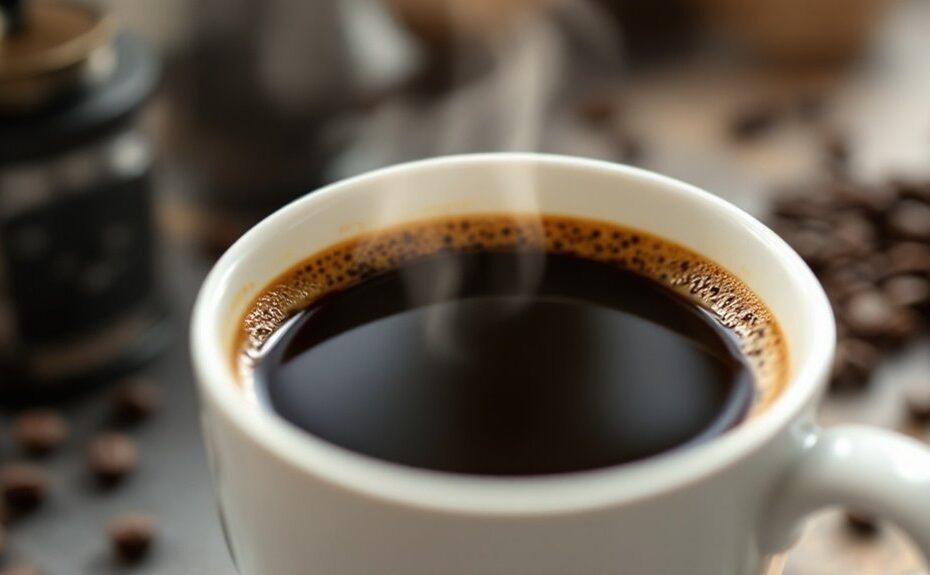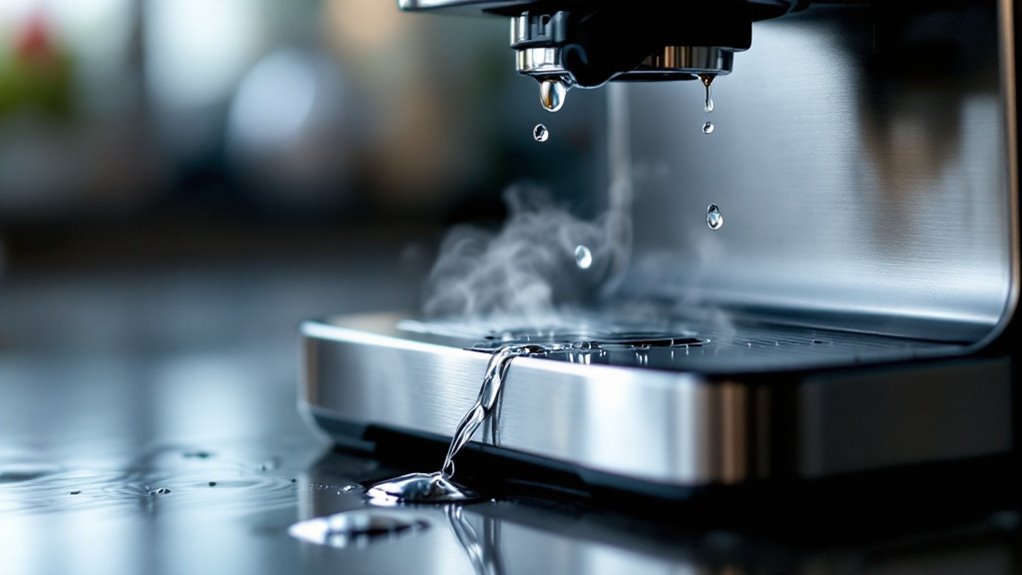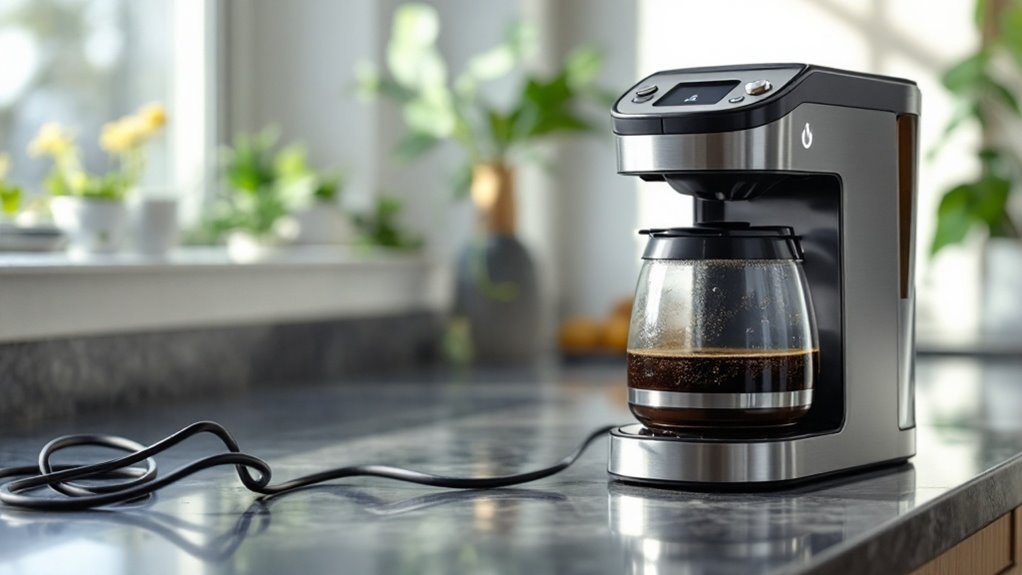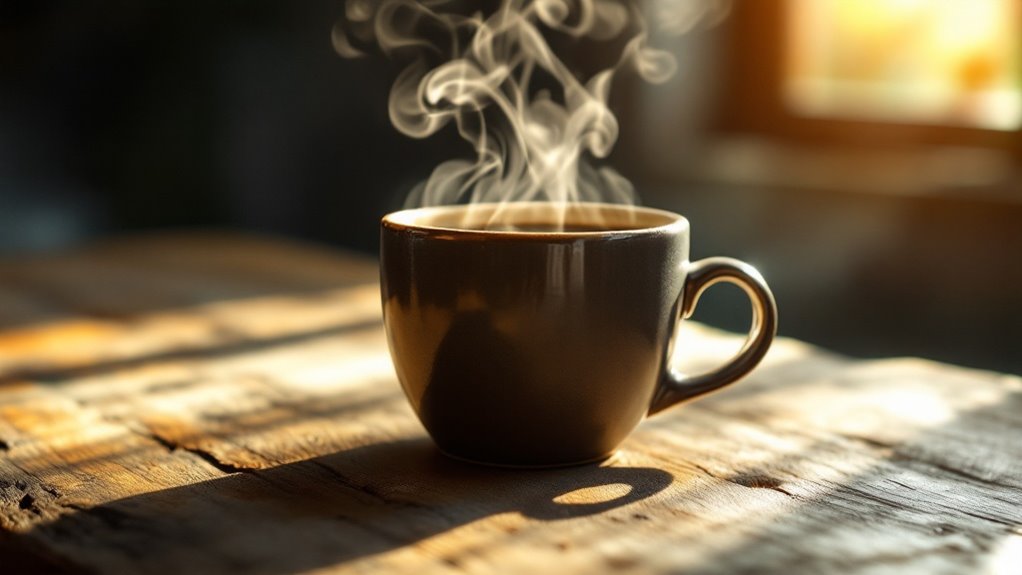







Imagine you've brewed a cup of coffee, only to find it so strong it's almost undrinkable. You might've used too much coffee or ground the beans too finely, but there's more to it than that. The strength of your coffee isn't just about the beans—it's influenced by factors like brew time, water temperature, and even the type of roast. If you're wondering why your morning cup feels overpowering, understanding these variables could be the key to balancing your brew. What adjustments could you make to achieve that perfect, smooth flavor? Let's explore.
Key Takeaways
- Using too much coffee grounds (e.g., a 1:12 ratio) can make your coffee overly strong and bitter.
- Over-extraction from fine grind size or long brew time intensifies coffee strength and bitterness.
- Brewing with water above 205°F accelerates extraction, creating a stronger, more bitter flavor.
- Dark roast beans naturally produce a stronger, more bitter coffee due to higher solubility of bitter compounds.
- Stale or pre-ground coffee can lead to uneven extraction, resulting in an overly strong and unpleasant taste.
Coffee-to-Water Ratio and Strength
The strength of your coffee is directly influenced by the coffee-to-water ratio, a critical factor in brewing. This ratio determines how much coffee taste and intensity you'll extract from the coffee grounds. A standard ratio of 1:16 (1 gram of coffee to 16 grams of water) produces a balanced brew, but you can adjust it to suit your preferences. If you prefer a strong brew, increase the coffee-to-water ratio, such as 1:12. This means more coffee grounds are used per unit of water, resulting in a higher concentration of dissolved solids and a bolder flavor. Conversely, a weaker brew is achieved with a lower ratio, like 1:18, which dilutes the coffee taste. For espresso, a concentrated drink, the ratio is typically 1:2, using 18 grams of coffee grounds to 36 grams of water. By tweaking the coffee-to-water ratio, you directly control the strength of your brewed coffee. Precision is key—measure your coffee and water accurately to achieve consistent results. Whether you crave a robust or mild cup, mastering this ratio guarantees your coffee taste aligns with your desired strength.
Grind Size Impact on Coffee Strength
Your grind size directly influences coffee strength by controlling how much surface area interacts with water during extraction. Finer grinds increase strength by extracting more coffee solids, while coarser grinds reduce it by allowing faster water flow and lower extraction. Adjusting your grind size helps balance strength, ensuring consistent flavor without over-extraction or under-extraction.
Grind Size and Extraction
Grind size directly influences how water interacts with coffee grounds, shaping the strength and flavor of your brew. A finer grind size increases the surface area exposed to water, enhancing extraction and producing a stronger, more intense cup. However, if the grind is too fine, it can slow the flow rate, extending brew time and leading to over-extraction, which results in bitterness. Conversely, a coarser grind size reduces surface area contact, speeding up the flow rate and shortening brew time. This leads to under-extraction, yielding a weaker, less flavorful coffee. The relationship between grind size and extraction is critical: finer grinds are ideal for methods like espresso, where high pressure and short brew times are used, while coarser grinds suit slower methods like French press. Inconsistent grind sizes disrupt this balance, causing uneven extraction and a mix of strong and weak flavors in your cup. To achieve ideal strength, you must match your grind size to your brewing method, ensuring the right balance of surface area, flow rate, and brew time.
Adjusting Grind for Balance
Adjusting grind size incrementally allows you to fine-tune your coffee's strength, guaranteeing a balanced extraction that avoids both bitterness and blandness. For drip coffee, aim for a medium grind resembling granulated sugar, which optimizes extraction without over-extracting the grounds. If your coffee tastes too strong, shift to a slightly coarser grind to reduce surface area contact, slowing extraction and softening the brew. Conversely, if it's weak, a finer grind increases extraction, intensifying the coffee's strength. For espresso, use a fine grind akin to confectioners' sugar to withstand high pressure and achieve a concentrated, robust shot. Small adjustments are key—overcorrecting can disrupt coffee brewing dynamics, leading to uneven extraction or clogged filters. Test each change by brewing a small batch, noting how the coffee tastes and adjusting further if needed. Consistency in grind size secures uniform extraction, preventing pockets of over- or under-extracted grounds. By mastering grind adjustments, you'll achieve a harmonious balance, tailoring your coffee's strength to your preference while preserving its nuanced flavors.
Brew Time and Extraction Levels
Brew time directly influences the extraction levels in your coffee, determining its strength and flavor profile. When you brew coffee, the duration of contact between water and grounds dictates how much soluble material is extracted. If your brewing coffee process takes too long, over-extraction occurs, dissolving excessive compounds like bitter tannins and making the coffee taste overly strong and harsh. Conversely, if the coffee is made with too short a brew time, under-extraction happens, leaving the coffee weak, sour, and lacking complexity. For drip coffee, aim for a brew time of 4-6 minutes, while espresso requires a precise 25-30 seconds. These ranges guarantee balanced extraction, where the coffee will taste rich and flavorful without being overpowering. Adjusting brew time within these parameters allows you to fine-tune the flavor of the coffee, achieving a harmonious balance between strength and nuance. Pay attention to your brewing method and timing to avoid extremes that compromise the quality of your cup.
Water Temperature and Flavor Balance
Water temperature's role in coffee brewing is critical to achieving a balanced flavor profile. When brewing, water temperature directly impacts extraction, determining whether your coffee tastes balanced or overly strong. Ideally, you should maintain a water temperature between 195°F and 205°F. Below 195°F, under-extraction occurs, leaving your coffee weak or sour. Above 205°F, over-extraction happens, dissolving too many compounds and creating a strong coffee with excessive bitterness. High water temperature accelerates extraction, increasing the concentration of dissolved solids and intensifying the brew. To avoid overly strong coffee, aim for consistent water temperature control. Using a PID-equipped machine guarantees even extraction, preventing fluctuations that disrupt flavor balance. If your coffee tastes too strong, try lowering the water temperature slightly, such as to 195°F–200°F. This adjustment reduces extraction intensity without sacrificing flavor balance, yielding a smoother cup. Precision in water temperature is key to avoiding the pitfalls of over-extraction and achieving a harmonious brew. By mastering this variable, you can control the strength of your coffee while maintaining its nuanced flavors.
Roast Level and Bitterness Intensity
The roast level of your coffee beans directly impacts bitterness intensity, with darker roasts like French or Italian producing more bitter compounds due to extended heat exposure. Light roasts retain brighter, acidic flavors, while medium roasts offer a balanced profile, reducing the risk of overwhelming bitterness. Over-roasting can degrade sugars, creating burnt, ashy notes that intensify bitterness and overshadow the bean's natural characteristics.
Roast Depth and Bitterness
Bitterness in coffee often stems from the roast level, with darker roasts like French or Italian intensifying this flavor profile. When roasted coffee beans undergo prolonged exposure to high temperatures, their sugars break down, and carbonization increases, leading to pronounced bitter flavors. A dark roast, such as French roast, pushes the beans to a point where their natural acidity diminishes, and smoky, charred notes dominate. This process amplifies the bitter characteristics, making the coffee taste stronger and more robust.
Light roasts, in contrast, retain more of the beans' inherent acidity and fruity undertones, resulting in a milder bitterness. Medium roasts strike a balance, offering caramelized sweetness and moderate acidity with a controlled level of bitterness. However, over-roasting can exacerbate bitterness, even in high-quality beans, by burning oils and organic compounds. The roast level directly influences the intensity of bitter flavors, with darker roasts typically delivering a more intense experience. If your coffee tastes excessively bitter, consider adjusting the roast level to better suit your palate.
Bean Type and Flavor Impact
Beyond roast depth, the type of coffee bean itself plays a significant role in shaping bitterness and overall flavor intensity. Dark roast beans undergo longer roasting times, which caramelize sugars and break down acids, resulting in a more intense, bitter flavor. If you prefer a bold, robust cup, dark roast beans are ideal, but they can easily overpower if over-extracted. Light roast beans, on the other hand, retain higher acidity and fruity, floral notes, producing a milder, less bitter coffee. These beans are less soluble, so they require precise brewing to avoid under-extraction. Medium roast beans strike a balance, offering moderate bitterness, a fuller body, and a harmonious blend of acidity and sweetness. However, over-roasted beans can develop a burnt, ashy taste, making your coffee excessively strong and bitter. The roast level directly influences the solubility of compounds during brewing, with darker roasts releasing more bitter compounds. Choosing the right bean type and roast level guarantees you achieve the desired strength and flavor profile without overwhelming bitterness.
Coffee Machine Settings and Adjustments
Adjusting your coffee machine settings can substantially impact the strength of your brew. If your coffee is too strong, start by modifying the coffee-to-water ratio. A standard ratio is 1:16 (1 part ground coffee to 16 parts water), but you can increase the water slightly to dilute the intensity. For an espresso machine, make sure the dose setting isn't excessive; a single shot typically uses 7-9 grams of ground coffee. Overdosing can lead to overpowering flavors. Next, check the grind size. Finer grinds extract more, intensifying the brew, so switch to a coarser grind if needed. If your machine allows, lower the brew temperature slightly, as higher temperatures can over-extract and amplify bitterness. Finally, reduce the brew time if your machine has adjustable settings. Longer extraction times pull more compounds from the grounds, resulting in a stronger cup. By fine-tuning these variables—dose, grind size, temperature, and time—you can make a balanced brew tailored to your preference.
Freshness of Coffee Beans and Grind
When it comes to brewing coffee, the freshness of your beans and grind plays a vital role in determining the strength and balance of your cup. Freshly roasted coffee beans retain their peak flavor for 2-4 weeks, but as they age, volatile compounds degrade, leading to a stronger, less balanced taste. Pre-ground coffee worsens this issue, as its increased surface area speeds up oxidation, resulting in a stale, overly strong flavor. To avoid this, grind your coffee beans right before brewing. This maintains freshness and prevents over-extraction, which can make your coffee taste harsh and overly intense. Stale beans, on the other hand, require a finer grind to make up for lost flavor, but this often increases extraction, making the coffee stronger and more bitter. Using a burr grinder guarantees a uniform grind size, which is essential for even extraction and preventing an imbalanced, overly strong brew. By prioritizing freshness in your coffee beans and grind, you'll achieve a more balanced and enjoyable cup.
Dilution Techniques for Balanced Coffee
If your coffee tastes too strong, you can easily balance it by using dilution techniques. Start by adding hot water to your brewed coffee, aiming for a 1:1 ratio to achieve a milder taste. This method guarantees you maintain flavor without over-extraction. For drip coffee, add 30-50 ml of water post-brew to lighten the strength. Alternatively, use bypass brewing by diverting a portion of water around the coffee grounds during the brew process. This reduces the amount of water interacting with the grounds, resulting in less coffee concentration. When making iced coffee, brew at double strength and dilute with ice as it melts, securing a balanced flavor. Experiment with small increments of water, such as 10 ml at a time, to fine-tune the strength to your preference. Make sure to adjust the amount of grounds you use if you consistently find your coffee too strong. By controlling the water-to-coffee ratio and experimenting with dilution, you can achieve a perfectly balanced cup every time.
Disclosure: As an Amazon Associate, I earn from qualifying purchases.







